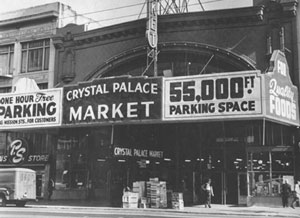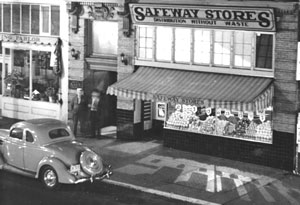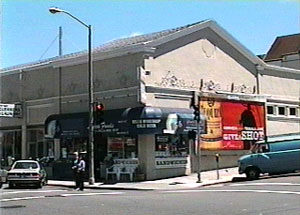Related: List of Known San Francisco Chain Grocery/Supermarket Locations, 1928-1999
In the 1920s, San Francisco was beginning its transformation from a city of independent grocers to a city of chain stores. And the city was growing as well; no longer hemmed in by Twin Peaks on the west and Bernal Heights on the south, development was spreading into the Sunset District, the Outer Mission, the Bayview District, and other areas. And the stores were following.

Crystal Palace, 8th and Market (SF Library).
The biggest news in 1923 San Francisco grocery retailing was the opening of the Crystal Palace Public Market at Eighth and Market Streets. With over 60,000 square feet of selling area and parking space for more than a thousand cars, this was THE place to shop. Stallholders sold groceries, produce, meats, coffee, ice cream, and more. Later, there were even departments for appliances and other household needs.

Unidentified location, probably in Nob Hill (SF Library).
About the same time, Marion Skaggs was opening San Francisco’s first Skaggs Cash Stores, one in the Mission District and one right inside the brand new Crystal Palace Market itself. Within four years, Skaggs Stores would merge with the Sam Seelig chain in Los Angeles to become Safeway Stores, one of the biggest names in the grocery industry and San Francisco’s dominant grocery retailer to this say. By 1928, Safeway served the city with 29 branches, plus one new Piggly Wiggly self-service store on Castro Street.
The chains had arrived in San Francisco with a vengeance. In addition to Safeway, Mutual Stores operated 59 San Francisco locations in 1928, Public Food had 69, and Pac Coast Stores had 15 branches of its own.

Former Mutual, later MacMarr, 1899 Irving Street.
Chain fever had thit the city hard and fast. Most stores were small, storefront operations in the 1000 square foot range. Most also did not contain butcher shops and featured at best a small assortment of produce; these commodities were generally purchased at merchants who specialized in them. Most stores also operated in economical mid-block locations, without parking, to serve a population which primarily used foot power or public transit.
Things would change significantly in the 1930s.

I would like to see my grandfather’s grocery store chain (10 stores, 2 warehouses) QFI- Quality Foods Incorporated located in San Francisco and the Bay Area in your article. Calisto Musso was an Italian immigrant from Milan.
Thanks,
Louis
What was the name of the store on the corner of Third St and Paul Ave across from B &J’s burgers
I would like to learn about Filing & Ingram Grocery which opened in 1905 at 22 nd Ave and California St. The name changed to Appel & Dietrich Fine Foods when my father Henry Appel snd Clifford Dietrich took over in 1953.
The MacMarr grocery store at 444 Taraval street. was purchased by my father (Ben Hom, 1960-80s) and became New Checker market (named for the store front tiles). Was a family run neighborhood business. My mother (Sue) and brother (David) and sisters (Ginger, Jeannie) and myself (Richard) worked there. There were 4 gas stations on the corners, hardware store and cleaners as well. It was a busy block with people stopping for gas and picking up groceries on their way home after work. Was replaced by a mixed use residential apartment building and store front in 1987.